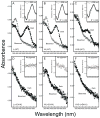X-linked cone dystrophy and colour vision deficiency arising from a missense mutation in a hybrid L/M cone opsin gene
- PMID: 23337435
- PMCID: PMC3594517
- DOI: 10.1016/j.visres.2012.12.012
X-linked cone dystrophy and colour vision deficiency arising from a missense mutation in a hybrid L/M cone opsin gene
Abstract
In this report, we describe a male subject who presents with a complex phenotype of myopia associated with cone dysfunction and a protan vision deficiency. Retinal imaging demonstrates extensive cone disruption, including the presence of non-waveguiding cones, an overall thinning of the retina, and an irregular mottled appearance of the hyper-reflective band associated with the inner segment ellipsoid portion of the photoreceptor. Mutation screening revealed a novel p.Glu41Lys missense mutation in a hybrid L/M opsin gene. Spectral analysis shows that the mutant opsin fails to form a pigment in vitro and fails to be trafficked to the cell membrane in transfected Neuro2a cells. Extensive sequence and quantitative PCR analysis identifies this mutant gene as the only gene present in the affected subject's L/M opsin gene array, yet the presence of protanopia indicates that the mutant opsin must retain some activity in vivo. To account for this apparent contradiction, we propose that a limited amount of functional pigment is formed within the normal cellular environment of the intact photoreceptor, and that this requires the presence of chaperone proteins that promote stability and normal folding of the mutant protein.
Copyright © 2013 Elsevier Ltd. All rights reserved.
Figures








References
-
- Asenjo AB, Rim J, Oprian DD. Molecular determinants of human red/green color discrimination. Neuron. 1994;12(5):1131–1138. - PubMed
-
- Carroll J, Dubra A, Gardner JC, Mizrahi-Meissonnier L, Cooper RF, Dubis AM, Nordgren R, Genead M, Connor TB, Jr, Stepien KE, Sharon D, Hunt DM, Banin E, Hardcastle AJ, Moore AT, Williams DR, Fishman G, Neitz J, Neitz M, Michaelides M. The effect of cone opsin mutations on retinal structure and the integrity of the photoreceptor mosaic. Invest Ophthalmol Vis Sci. 2012;53(13):8006–8015. - PMC - PubMed
Publication types
MeSH terms
Substances
Supplementary concepts
Grants and funding
LinkOut - more resources
Full Text Sources
Other Literature Sources
Medical

